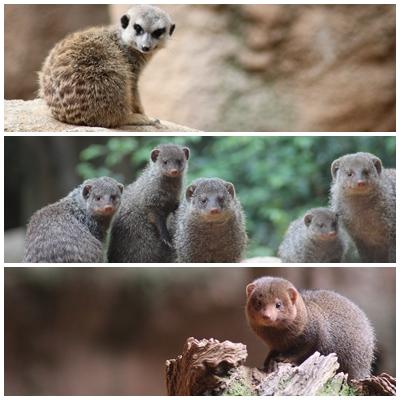Background

Animals in captivity can be deprived of performing some of their natural behaviours. Using enrichments may allow them to express a larger part of species-specific behaviour repertoire and with a better frequency distribution.
Shepherdson (1994) stated: ‘behavioural opportunities that may arise or increase as a result of environmental enrichment can be appropriately described as behavioural enrichment’. This can increase the animals’ ability to manage challenges and their positive use of the environment and decrease frequencies of abnormal behaviour (Young, 2003). The enrichments aim at achieving the full expression of natural behaviour patterns (Young, 2003) and to increase activity levels (Bolgan et al., 2009) in captive animals.
The present study focused on meerkats (Suricata suricatta), banded mongooses (Mungos mungo) and dwarf mongooses (Helogale parvula) (Fig.1). These species are included in the family Herpestidae, which consist of 14 genera and 33 species found in southern Asia, the East Indies, Africa and Europe (Bothma, 1998; Nowak, 1999). All three species live in the African continent in social groups or packs in semi-deserts, savannahs or open woodland regions (Bothma, 1998), with warm climates where animals can find their optimal temperatures between 20 – 25ºC (AZA Small Carnivore TAG, 2011).
Aims
This project aims to study the effect of environmental enrichment on the behaviour of meerkats, banded mongooses and dwarf mongooses in human care. To achieve this goal two different types of enrichments were tested: (1) a food enrichment with several variations and (2) an olfactory enrichment with the presentation of two new odours.
References:
AZA Small Carnivore TAG (2011). Mongoose, Meerkat, & Fossa (Herpestidae/Eupleridae) Care Manual. Association of Zoos and Aquariums, Silver Spring, MD. pp.103.
Bolgan, M., Rodeano, M., Manna, D., & Ferrero, E. A. (2009). Animal welfare and scientific research: the meerkat group at Parco Zoo Punta Verde. Int. Zoo Yb, 374, 281-288.
Bothma, J. du P. (1998). Carnivore ecology in arid lands. Adaptations of desert organisms. Springer.
Nowak, R. (1999). Walker’s Mammals of the World, Vol. 1. Baltimore: The Johns Hopkins University Press.
Shepherdson, D. (1994). The role of environmental enrichment in the captive breeding and reintroduction of endangered species. In Creative Conservation (pp. 167-177). Springer, Dordrecht.
Young, R. J. (2003). Environmental Enrichment for Captive Animals. Oxford, UK. Malden, MA: Blackwell Science.
Responsible for this page:
Director of undergraduate studies Biology
Last updated:
05/09/20
